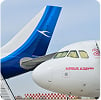Dubai Airshow is part of the Informa Markets Division of Informa PLC
This site is operated by a business or businesses owned by Informa PLC and all copyright resides with them. Informa PLC's registered office is 5 Howick Place, London SW1P 1WG. Registered in England and Wales. Number 8860726.
Sustainability
Contributing to a sustainable economy
We're dedicated to ensuring the Dubai Airshow positively impacts both people and planet. Our goal is to drive industry sustainability by fostering connections between individuals.
Sustainability
Contributing to a sustainable economy
Dubai Airshow’s commitment to sustainability
At Informa, we achieve sustainable commercial success through thoughtful market focus and superior results for our customers. Being a sustainable business is central to how we run our events, how we make decisions and how we do business every day.
Our continuing evolution is fueled by insight, innovation, and collaboration. We are proud of our commitment to having a positive environmental and social impact on both the communities and industries we work within.
Sustainability
Dubai Airshow’s commitment to sustainability
At Informa, we achieve sustainable commercial success through thoughtful market focus and superior results for our customers. Being a sustainable business is central to how we run our events, how we make decisions and how we do business every day.
Our continuing evolution is fueled by insight, innovation, and collaboration. We are proud of our commitment to having a positive environmental and social impact on both the communities and industries we work within.
Maximise your visibility
The opportunities
FasterFoward is Informa's approach to sustainable business. Under the Faster to Zero pillar, we are moving faster to become a zero waste and net zero carbon business.
Our objectives
Sustainability initiatives
Lorem ipsum dolor sit amet consectetur. Nunc lacus quis quisque potenti suscipit interdum sit. In auctor arcu bibendum massa egestas blandit dictumst.
As part of Informa's continued commitment to sustainability, Dubai Airshow 2025 exhibition, conference, and chalets are powered by 100% renewable electricity
Dubai Airshow will be part of the Better Stands Programme, which aims to reduce the single use disposable stands at exhibitions in favour of reusable structures
Dubai Airshow will be using recycled and environmentally friendly materials for event merchandise like lanyards, badge holders, and event bags
Dubai Airshow has partnered with Rove Hotel for our sustainable partnership, who are part of the Green Key Initiative that aims to achieve a more sustainable eco-friendly operation of hotels around the world
Key sustainability themes and challenges will be discussed with the industry to help create a cleaner environment
Dubai Airshow introduces the Wellness Zone, a dedicated space designed to support attendees' mental and physical well-being, fostering a healthier and more balanced show experience.
How you can get involved
We are working with exhibitors, event partners and attendees to make Dubai Airshow a sustainable event. As part of this plan, we have developed suggestions and tips for building a sustainable aerospace event.
What visitors can do
★ While you are at the show, be aware of what waste you are generating. Reduce where possible and use the provided recycling bins when appropriate
★ As a visitor, your biggest environmental impact is from travelling to and from the event. When possible, choose public transport and trains over planes and taxis
★ When booking accommodation, consider a hotel with eco-certifications to lower your carbon footprint, and be sure to ask about any specific programs your hotel may have when you check in
★ Reduce your environmental impact by eating one plant-based meal a day
★ Take a break from the show floor and recharge in the Wellness Zone with calming activities designed to refresh your mind and body
What exhibitors can do
★ Inspire the sustainable development of your industry by promoting your company's and your products'sustainability credentials
★ Make sure you and your contractor and compliant with all health, safety and security requirements
★ Be digitally present - Avoid printing and download the event app ahead of the event to plan your time
★ Select energy-efficient lighting and equipment for your stand and be sure to power down your equipment at the end of the day
★ Support your team's well-being by encouraging visits to the Wellness Zone - helping them stay energised, focused, and ready to engage
Explore more
A whole world to discover
Lorem ipsum dolor sit amet consectetur. Nunc lacus quis quisque potenti suscipit interdum sit. In auctor arcu bibendum massa egestas blandit dictumst. Sed.
Stay up to date
Get the most recent news on the Dubai Airshow delivered directly to your inbox.
By subscribing you agree to our Terms and Conditions


